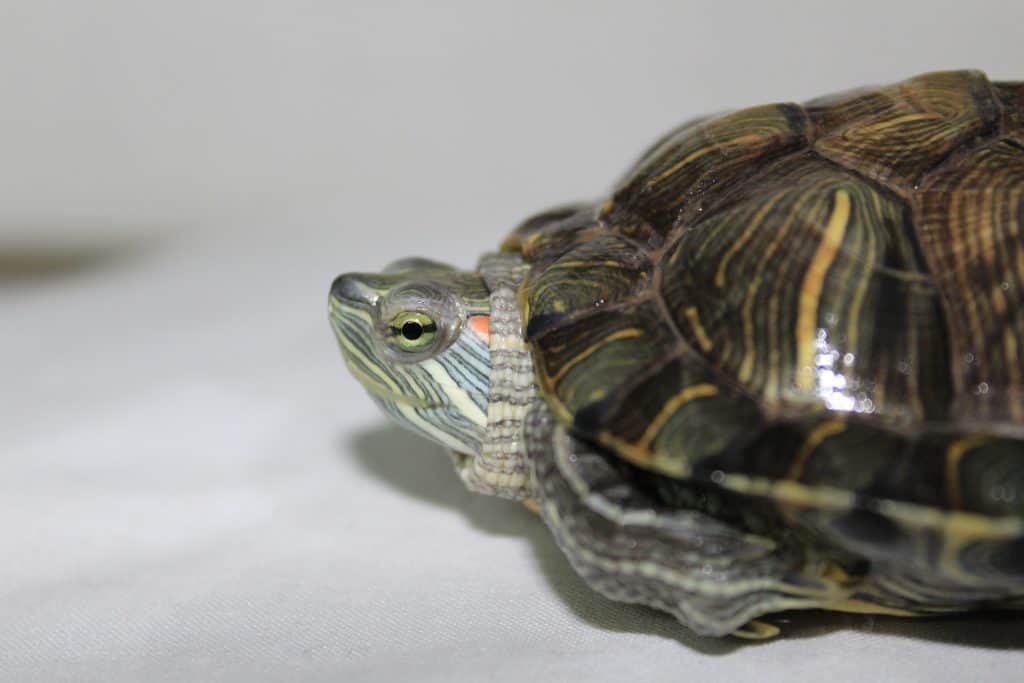Observing your turtle’s activity level is one way to tell if your turtle is happy. A healthy, happy turtle will be active and alert, moving around its enclosure and exploring its surroundings.
On the other hand, a turtle that is lethargic or inactive may be sick or stressed. Additionally, a happy turtle will have a healthy appetite and eagerly eat its food.
Another sign of a happy turtle is healthy skin and shell. For example, a turtle with a smooth, shiny shell and clear, bright eyes is likely healthy. Conversely, a turtle with a soft, discolored shell or cloudy eyes may suffer from a health issue or poor living conditions.
Keeping your turtle’s habitat clean and providing proper nutrition and lighting can help your pet stay healthy and happy.
Physical Indicators of a Happy Turtle

As a turtle owner, it’s essential to know whether your pet is happy or not. By observing your turtle’s behavior and physical appearance, you can determine if they are content and healthy. Here are some physical indicators of a happy turtle:
Activity Level
A happy turtle is an active turtle. If your turtle is swimming around its tank, basking in the sun, and exploring its environment, it’s a good sign that they are happy. However, if your turtle is lazy and not moving much, it could indicate illness or stress.
Appetite
A healthy and happy turtle has a good appetite. If your turtle eagerly eats its food and shows interest in treats, it’s a good sign that they are content. However, if your turtle is not eating or has a decreased appetite, it could be a sign of illness or stress.
Appearance
The appearance of your turtle can also be an indicator of its well-being. A happy turtle has clear, bright eyes, a smooth, shiny shell, and healthy skin. Conversely, if your turtle’s eyes are cloudy, its shell is damaged or discolored, or its skin is flaky or dry, it could be a sign of illness or stress.
To ensure your turtle is happy and healthy, monitor their activity level, appetite, and appearance. If you have any concerns, seek advice from a reptile veterinarian.
Behavioral Indicators of a Happy Turtle
If you own a turtle, you may be curious about how to determine its content. Even though turtles express emotions differently than humans, some behavioral signs may suggest a pleased turtle. Below are some behavioral indicators of a happy turtle:
Interaction with Environment
A happy turtle will show an interest in its environment. It will explore its enclosure, bask in the sun or under a heat lamp, and swim in the water. On the other hand, if your turtle spends most of its time hiding or not moving much, it may be a sign of stress or illness.
Another sign of a happy turtle is if it is eating well. A healthy and content turtle will have a good appetite and eagerly eat its food. Conversely, if your turtle is not eating, it may indicate illness or stress.
Interaction with Owner
A happy turtle will also interact with its owner. While turtles may not show affection in the same way as dogs or cats, they can still recognize their owners and show interest in them. If your turtle swims up to you when you approach its enclosure, it may signify a happy turtle.
However, it’s important to remember that turtles are not social animals and may not enjoy being handled or petted.
Overhandling can cause stress and harm to your turtle. It’s best to observe your turtle from a distance and provide a comfortable and stimulating environment.
In conclusion, a happy turtle will show an interest in its environment, have a good appetite, and interact with its owner in its way. Therefore, by observing your turtle’s behavior, you can ensure it is healthy and content in its home.
Environmental Factors that Affect a Turtle’s Happiness
To determine your turtle’s happiness, it’s essential to evaluate the environmental factors that impact its health. Here are some crucial factors to consider:
Tank Size and Setup
The size and setup of your turtle’s tank can significantly impact its happiness. Turtles need ample space to swim and explore, so ensure their tank is large enough to move around comfortably. As a general rule, the tank should be at least four times the length of your turtle.
You should also provide plenty of hiding spots and climbing areas for your turtle. This will give them a sense of security and help prevent boredom. Some good options include rocks, logs, and plants.
Water Quality and Temperature
The quality and temperature of your turtle’s water are also important. Turtles need clean, filtered water to stay healthy and happy. You should also ensure the water is the right temperature for your turtle’s species.
Different types of turtles have different temperature requirements, so do some research to find out what’s best for your pet.
It’s also essential to monitor the water quality regularly. Test the water frequently for ammonia, nitrite, and nitrate levels, and make sure the pH is within the appropriate range for your turtle.
Lighting and Basking Area
Turtles need access to UVB lighting to help them absorb calcium and stay healthy. Ensure your turtle’s tank has a UVB light appropriate for their species. You should also provide a basking area where your turtle can rest and soak up heat. This should be a dry area with a heat lamp or other heat source.
Overall, paying attention to these environmental factors can go a long way in ensuring your turtle is happy and healthy. By providing a comfortable and stimulating environment, you can help your turtle thrive.
Conclusion
Knowing whether your turtle is happy is essential for their health and well-being. By paying attention to their behavior, diet, and environment, you can get a good idea of their happiness level. Remember, a happy turtle is a healthy turtle!
If you notice any signs of illness or discomfort, taking your turtle to a veterinarian is essential. They can provide a proper diagnosis and treatment plan to ensure your turtle gets the necessary care.
Overall, taking care of a turtle can be a rewarding experience. You can help your turtle live a happy and healthy life with proper attention and care.




Leave a Reply